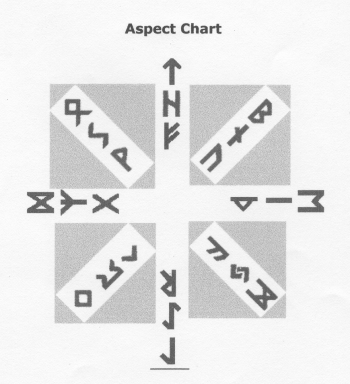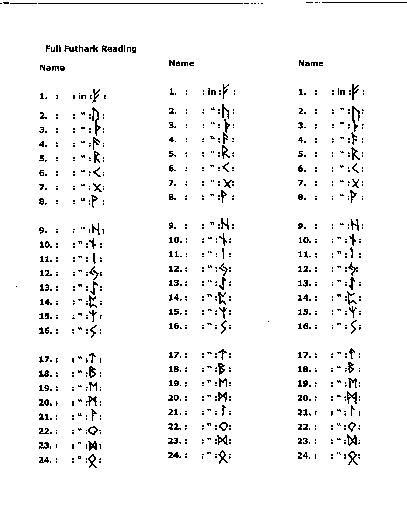 This is the rune known as 'Dagaz'. This (Thorsson tells us) represents the ultimate principle of bipolar creativity, in which, in the light of "Day", all seemingly polar opposites are brought together and understood. This rune brings the boon of archetypal awareness and suggests a source — the only true source — of hope and happiness. It is the rune of enlightened consciousness, and a great awakening is at hand. Dagaz is also the rune of the true seeker.
This is the rune known as 'Dagaz'. This (Thorsson tells us) represents the ultimate principle of bipolar creativity, in which, in the light of "Day", all seemingly polar opposites are brought together and understood. This rune brings the boon of archetypal awareness and suggests a source — the only true source — of hope and happiness. It is the rune of enlightened consciousness, and a great awakening is at hand. Dagaz is also the rune of the true seeker.
M-1
To answer the question, "What is a Muggle?", one could say it is a person who truly believes that Descartes was right when he said "I think, therefore I am." A true Muggle, which includes anyone who is convinced that ego-intellect is his or her identity, and is therefore a 'prisoner' of 'thought', will fiercely deny any validity to true Divination and will refuse to discuss the matter.
Let's leave it at that, and go right on into more interesting matters.
M-2
We have mentioned the irrational a number of times in these lessons, not to irritate or confuse you but to get used to the notion that Rune Lore and Divination in general are intimately involved with the irrational aspect of Reality.
Many folks still have trouble with this statement, but it is true that every unique event in the Universe has the irrational as an essential component. Let me give you an example: I wear glasses when reading. My glasses are unique, in that they can be distinguished from all other similar pairs; they are also unique in that they contain a particular, unduplicated collection of atoms, electrons, sub-atomic particles, etc. I can identify most of the component parts and features of my glasses, but I cannot reach beyond the particle level and explain how and why these particular particles have come together in just this single 'event' (my glasses) and in just these unique and singular ways. I have reached the irrational.
More important, it is in the irrational that the true uniqueness of each event is based. To look at that another way, I may be satisfied that I am a unique individual...my name, my address, my phone number, my social security number, my blood type...all specify a particular unique individual. However, none of those bits of physical data can conclusively prove my uniqueness; for that, I must resort to my DNA...which is not something I can simply pull out and display.
Therefore, when I want to reach and 'communicate with' a particular unique event, I do so most easily and most accurately by addressing that event's irrational component or aspect. It should not be surprising, then, that the most useful communication 'tool' is something irrational itself. That brings us back to the I Ching and the Runes (among others).
Very well, let's boil all this verbiage down into something simpler. Using irrational methods, one can 'communicate' with any other unique event (person, idea, image, item of information, physical object, etc.)... provided that one k/gnows how. Not only that, one can further attract the other unique event to one's self as well. Generally, none of this happens in 'ordinary' linear, causal connection, but rather through something called 'Synchronicity'.
What's that?
In his Preface to Wilhelm's translation of the I Ching, C. G. Jung gives an excellent introduction to his term 'Synchronicity'. Equally useful are his remarks about our Western linearity and the breakdown of intellectual analysis when we attempt to apply it to qualitative inquiry. Useful as they are, Jung's writings are not really for the beginner and we need to attempt a simpler and more basic path to comprehension.
 Like math students using 'X' and 'Y' to represent almost anything, let's imagine that we are interested in four unique 'events' that we shall call A, B, C, and D.
Like math students using 'X' and 'Y' to represent almost anything, let's imagine that we are interested in four unique 'events' that we shall call A, B, C, and D.
In our habit of thinking in terms of linear causality, we say-think-believe that if A happens, then that makes B happen, which creates C, resulting in D.
 If A happened first, then A must be in the 'Past', and we can ask The Past to tell us about it. That's just the way it works (we believe), because of the Law of Cause and Effect. This reasoning gets rather shakey when we are forced to discover that Cause and Effect isn't a Law at all, but merely a statistical probability (at best)... and that is getting uncomfortably close to the Irrational.
If A happened first, then A must be in the 'Past', and we can ask The Past to tell us about it. That's just the way it works (we believe), because of the Law of Cause and Effect. This reasoning gets rather shakey when we are forced to discover that Cause and Effect isn't a Law at all, but merely a statistical probability (at best)... and that is getting uncomfortably close to the Irrational.
 Our Runes, however, are not deceived. Following Synchronicity, they discover everything mingling and interacting, becoming always new, in the Present... as Content of what we gnow as The Now.
Our Runes, however, are not deceived. Following Synchronicity, they discover everything mingling and interacting, becoming always new, in the Present... as Content of what we gnow as The Now.
Divination is not the only instance of Synchronicity in action, far from it. In fact, we can shrink this impressive word (Synchronicity) down to a comfortable size by consdering an experience that many, many people have had at least once in their lives.
Imagine, if you will, that you are busily going about your daily routine, but that you are actually quite distracted by an urgent need for a particular bit of information. You have no idea where or how to find this information, and yet you must have it. Your day unfolds as usual, when you suddenly feel the powerful urge to stop, park, and go to a location you did not plan to visit today. You attempt to dismiss the urge as silly (irrational?), but it gets stronger and so you do park and go in. There you meet someone who was also 'led' to be in that location this day, and surprisingly this person has the exact information you need... and gives it to you.
This little scenario took place (as it does, perhaps daily) through the operation of Synchronicity. If you try to explain it any other way, you will wind up in contradictions, logical impossibilities, and frustration.
I will certainly not hold you responsible for all this about Synchronicity, the funtioning of the irrational, acausal communication, or any of those daunting notions. This is being included here just to let you know that the subject exists and to introduce you to a few of its ideas. If you continue with your studies of Runes or any form of Divination, you will encounter this material again; now, it won't come as a shock to you.
All right, now for something completely different.
After all this talk about the irrational, and how important it is to Rune work, I am going to show you something extremely seductive (for some) and dangerous. In Runecaster's Handbook, Dr. Thorsson describes a layout using all 24 Runes of the Elder Futhark and introduces something called Aspects, new to us here in this course.
 This is Dr. Thorsson's chart for the sequential layout of the full Futhark. The first Rune drawn (blind, of course)is placed on square 1, the next Rune on square 2, the next on square 3, and so on in a sort of semi-spiral until all the squares are covered.
This is Dr. Thorsson's chart for the sequential layout of the full Futhark. The first Rune drawn (blind, of course)is placed on square 1, the next Rune on square 2, the next on square 3, and so on in a sort of semi-spiral until all the squares are covered.
To 'read' this display, the vitki begins at the first position of the first Aett... fehu, and reads "Name of Rune cast on Fehu", then "Name of Rune cast on Uruz", and so on around the 'normal' sequence of the 3 Aettir. In this, the cast Runes sort of 'unfold' themselves from the inside out. As a result, one has all 24 Runes cast into a temporary relationship with all 24 of the original Futhark, or 48 factors to consider in searching for meaning.
But it doesn't stop there. Let's imagine, for example, that the 23rd Rune cast (onto square 23, the 'home' of Fehu) turns out to be Isa. Now Isa would have a somewhat chilling or constricting effect on Fehu anyway, but now we have the added dimension of Aspects. What is the angular relationship between Isa and Fehu (quite aside from this layout)?
 This is the chart Dr. Thorsson gives us, showing the angular relationships between all the Runes of the Elder Futhark. They are shown in groups of three, at each of the eight 'points' of the divided circle. From this it is easy to see which Runes are 'conjunct', which are at 45 degrees, which at 90 degrees, and so on around the 360 degrees of the circle.
This is the chart Dr. Thorsson gives us, showing the angular relationships between all the Runes of the Elder Futhark. They are shown in groups of three, at each of the eight 'points' of the divided circle. From this it is easy to see which Runes are 'conjunct', which are at 45 degrees, which at 90 degrees, and so on around the 360 degrees of the circle.
Going back to Isa and Fehu, we find that they stand in an aspect of 90 degrees, or 'square' to each other. This is a 'difficult' or straining aspect, meaning that the two Runes do not naturally harmonize easily (if at all). This, in our example, would suggest that money matters as well as psychic energies would be a rather difficult area at the present moment for the person or situation for which we are reading.
 Obviously, all this information is too much to remember after a Casting, and so Dr. Thorsson suggests charting the results in a way that identifies which Runes were cast onto which basic Rune-positions. This is the chart I have made for my own use, with 24 blank spaces followed by the Runes that normally 'inhabit' each position.
Obviously, all this information is too much to remember after a Casting, and so Dr. Thorsson suggests charting the results in a way that identifies which Runes were cast onto which basic Rune-positions. This is the chart I have made for my own use, with 24 blank spaces followed by the Runes that normally 'inhabit' each position.
I was first attracted to this 'Futhark Method' because it reminded me of an astrological chart, with positions and aspects as important parts of the reading. It appealed to my intellectual curiosity, and so represented a serious and dangerous challenge to me as a Runester (vitki). It could easily have diverted me totally from the intuitive realtionship I was developing with the Runes and with Synchronicity, the power of Now, and the rest of the Real Universe. It is doubtless sometimes useful, in ways and in details that no other layout can equal, but it must be handled in much the same way that one handles a box of dynamite..with enormous respect and care. If you decide to play with this 'Futhark Method', observe yourself very carefully. If it becomes quite attractive to you, if you are inclined (tempted?) to use it more and more often, put it all away and go back at once to a simple three-Rune Nornic layout, and to your day-dreams and story-spinning. An addiction can be extremely difficult to break.
M-3
Sometimes when a Muggle hears me speak about rune-casting or some other form of divination, he will snort something like "Oh baloney! That's quite irrational!"
When that happens, I like to smile and agree "Of course it is, or it wouldn't work!"
It has been a pleasure serving you in this course; I have enjoyed your work, and I do hope that you have also, at least to some degree. Good luck on your paths, and perhaps ours will cross again sometime.
Prof. Wastl
Assignment Four
Your Assignment ('homework') for this lesson is waiting for you at the link below. Be sure to follow the instructions for submission carefully. (You may need to consult previous lessons.)
Good luck, and enjoy playing with Runes!

